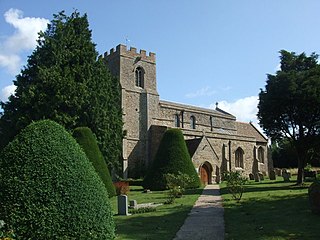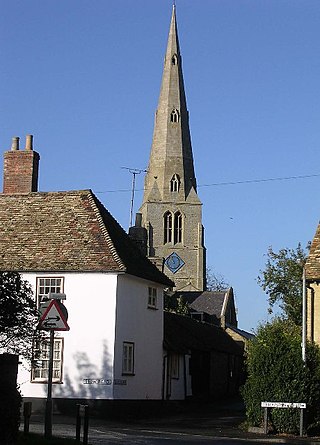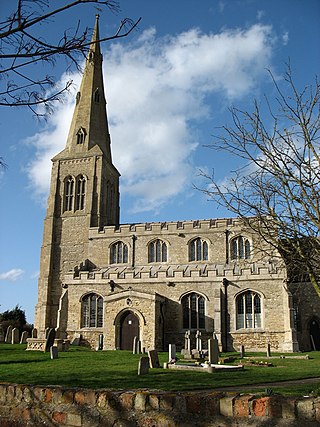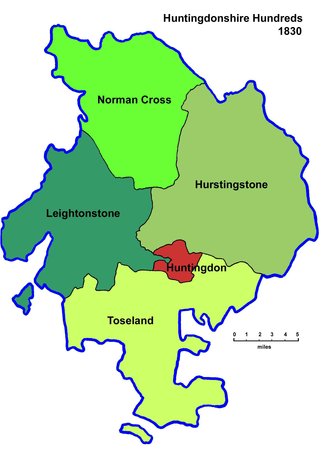
Eynesbury is an urban area in the civil parish of St Neots, in the Huntingdonshire district of Cambridgeshire, England. It mainly consists of housing, although there is an area of light industry, and a large supermarket. In addition there is a large area of open grassland and a caravan park.

Hemingford Grey is a village and civil parish in Cambridgeshire, England. Hemingford Grey lies approximately 4 miles (6 km) east of Huntingdon. Hemingford Grey is situated within Huntingdonshire which is a non-metropolitan district of Cambridgeshire as well as being a historic county of England.

Yelling is a linear village and civil parish in the Huntingdonshire administrative district of Cambridgeshire, England. The village is about 5 miles (8 km) east of St Neots and 6 miles (10 km) south of Huntingdon.

Buckworth is a village and civil parish in Cambridgeshire, England. Buckworth lies approximately 7 miles (11 km) northwest of Huntingdon and covers an area of 2,023 acres. It is also a part of the hundred called Leightonstone. Buckworth is situated within Huntingdonshire which is a non-metropolitan district of Cambridgeshire as well as being a historic county of England.

Keyston is a village and former civil parish, now in the parish of Bythorn and Keyston, in Cambridgeshire, England. Keyston lies approximately 12 miles (19 km) west of Huntingdon, near Molesworth. Keyston is situated within Huntingdonshire which is a non-metropolitan district of Cambridgeshire as well as being a historic county of England. In 1931 the parish had a population of 151.

Great Paxton is a village and civil parish in Cambridgeshire, England. It is in Huntingdonshire which is a non-metropolitan district of Cambridgeshire as well as being a historic county of England. The village lies 2.6 miles (4.2 km) north of St Neots in the Great Ouse river valley.

Fenstanton is a village and civil parish in Cambridgeshire, England, 2 miles (3 km) south of St Ives in Huntingdonshire, a non-metropolitan district of Cambridgeshire and historic county. Fenstanton lies on the south side of the River Ouse.
Wood Walton is a village and civil parish in Cambridgeshire, England. Wood Walton lies approximately 6 miles (10 km) north of Huntingdon and just east of the A1. Wood Walton is situated within Huntingdonshire which is a non-metropolitan district of Cambridgeshire as well as being a historic county of England.

Catworth is a village and civil parish in Cambridgeshire, England. Catworth lies approximately 9 miles (14 km) west of Huntingdon. The civil parish covers an area of 3,094 acres. Catworth village has two parts, Catworth, at the top of the hill, and Little Catworth, at the bottom. Catworth is situated within Huntingdonshire which is a non-metropolitan district of Cambridgeshire as well as being a historic county of England.
The Offords is the name given to the two villages of Offord Cluny and Offord D'Arcy, situated on the east bank of the River Great Ouse between Saint Neots and Huntingdon in west Cambridgeshire. The Offords were both recorded in the Domesday Book as 'Upeforde' under two different landowners, which suggests they were one village at that time. By the 13th Century they had evolved into two distinct settlements, and remained so until the proximity and resulting close co-operation of the two villages lead to their merger in 2010. In 2008 the Parish Councils merged, and in 2010 the Huntingdon (Parishes) Order 2009 officially created the new Parish of 'Offord Cluny and Offord D'Arcy'.

Hail Weston is a village and civil parish in Cambridgeshire, England. Hail Weston lies approximately 7 miles (11 km) south of Huntingdon. Hail Weston is situated within Huntingdonshire which is a non-metropolitan district of Cambridgeshire as well as being a historic county of England.

Ellington is a village and civil parish in Cambridgeshire, England, 4 miles (6 km) west of Huntingdon in Huntingdonshire, a non-metropolitan district of Cambridgeshire and historic county of England. The civil parish covers an area of 2,700 acres ; much of it is grassland with some small woods in the south of the parish.

Offord Cluny is a village and former civil parish, now in the parish of Offord Cluny and Offord D'Arcy. It is 4.9 miles (7.9 km) north of St Neots and 3 miles (4.8 km) south-west of Huntingdon. Offord Cluny is in Huntingdonshire which is a non-metropolitan district of Cambridgeshire as well as a historic county of England. Offord Cluny is the twin village of Offord D'Arcy and together they are known as The Offords. At the time of the 2001 census, the population of Offord Cluny was 502 people. Historically both had their own parish councils but these were merged in 2009. Council tax rates are higher in Offord Cluny than in Offord D'Arcy.

Brington is a village and former civil parish, now in the parish of Brington and Molesworth, in Cambridgeshire, England. Brington lies approximately 9 miles (14 km) north-west of Huntingdon. Brington is situated within Huntingdonshire which is a non-metropolitan district of Cambridgeshire as well as being a historic county of England. In 1931 the parish had a population of 75.

Offord D'Arcy is a village and former civil parish, now in the parish of Offord Cluny and Offord D'Arcy. It is 4 miles (6.4 km) north of St Neots and 3 miles (4.8 km) south-west of Huntingdon. Offord D'Arcy is in Huntingdonshire which is a non-metropolitan district of Cambridgeshire as well as a historic county of England. It is the twin village of Offord Cluny and together they are known as The Offords. Historically both villages had their own parish councils but the two civil parishes were merged on 1 April 2010. At the time of the 2001 census, the population of Offord D'Arcy was 747 people.
The English county of Huntingdonshire has existed since Anglo-Saxon times.
John Hunt, D.D. was a Scottish cleric, theologian and historian. He was known for his liberal views, and his work Religious Thought in England.

Hurstingstone was a hundred of Huntingdonshire, England that was mentioned in the Domesday Book of 1086.
William de Brus, was an Anglo-Scottish knight. He was a younger son of Robert de Brus, 5th Lord of Annandale and Isabella de Clare.

Norman Cross is a hamlet in the Huntingdonshire district of Cambridgeshire, England. It lies south of Peterborough, between the villages of Folksworth, Stilton and Yaxley, and at the junction of the A1 and A15 roads. Traditionally in the county of Huntingdonshire, Norman Cross gave its name to one of the hundreds of Huntingdonshire and, from 1894 to 1974, to Norman Cross Rural District. The hamlet is situated partly in the civil parish of Folksworth and Washingley, west of the A1, and partly in Yaxley parish, to the east.















